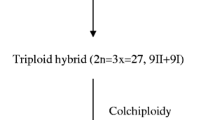Summary
Earlier students of the origin of Lotus corniculatus suggested that this tetraploid species arose as an autotetraploid of the closely related diploid species L. tenuis or L. alpinus. More recent studies suggested that L. alpinus and L. japonicus could be ancestral forms. The present study of tannin content, phenolic content, cyanide production, morphology, cytogenetics, Rhizobium specificity and self-incompatibility in the corniculatus group virtually excludes the possibility that L. corniculatus could have arisen through autopolyploidy of L. tenuis or L. alpinus, and suggests that L. corniculatus arose through hybridization of L. alpinus and/or L. tenuis (probably as female parent) with L. uliginosus (probably as male parent), followed by chromosome doubling in the hybrid.
Similar content being viewed by others
References
Ball PW (1968) Lotus. In: Tutin TG, Heywood VH, Burges NA, Valentine DH, Walters SM, Webb DA (eds) Flora Europaea. Cambridge University Press, London, pp 173–175
Bell TA, Etchells JL, Smart WWG (1965) Pectinase and cellulase enzyme inhibitor from sericea and certain other plants. Bot Gaz 126:40–45
Bent FC (1962) Interspecific hybridization in the genus Lotus. Can J Genet Cytol 4:151–159
Bubar JS (1958) An association between variability in ovule development within ovaries and self-incompatibility in Lotus (Leguminosae). Can J Bot 36:65–72
Charlton JFL, Wilson ERL, Ross MD (1978) Plant introduction trials. Performance of Lotus corniculatus as spaced plants in Manawatu. NZ J Exp Agric 6:201–206
Clapham AR, Tutin TG, Warburg EF (1952) Flora of the British Isles. Cambridge University Press, London
Dawson CDR (1941) Tetrasomic inheritance in Lotus corniculatus L. J Genet 42:49–72
De Latour G, Jones WT, Ross MD (1978) Production of interspecific hybrids in Lotus aided by endosperm transplants. NZ J Bot 16:61–68
Feeney FF (1968) Effect of oak leaf tannins on larval growth of the winter moth Operophtera brumata. J Insect Physiol 14:805–817
Forde MB, De Latour G (1978) Plant introduction trials. Classification of Lotus introductions. NZ J Exp Agric 6:293–297
Grant WF, Bullen MR, Nettancourt D de (1962) The cytogenetics of Lotus. 1. Embryo-cultured interspecific diploid hybrids closely related to L. corniculatus L. Can J Genet Cytol 4:105–128
Grant WF, Sidhu BS (1967) Basic chromosome number, cyanogenetic glucoside variation, and geographic distribution of Lotus species. Can J Bot 45:639–647
Harney PM, Grant WF (1964a) The cytogenetics of Lotus (Leguminosae). 7. Segregation and recombination of chemical constituents in interspecific hybrids between species closely related to L. corniculatus L. Can J Genet Cytol 6:140–146
Harney PM, Grant WF (1964b) A Chromatographic study of the phenolics of species of Lotus closely related to L. corniculatus and their taxonomic significance. Am J Bot 51: 621–627
Harney PM, Grant WF (1965) A polygonal presentation of Chromatographic investigations on the phenolic content of certain species of Lotus. Can J Genet Cytol 7:40–51
Jaronowski J, Wojciechowska B (1963) Cytological studies in the genus Lotus. 2. Embryology of the interspecific cross L. corniculatus L. x L. tenuifolius L. Genet Pol 4:277–292
Jones DA (1962) Selective eating of the acyanogenic form of the plant Lotus corniculatus by various animals. Nature 193:1109–1110
Larsen K (1954) Cytological studies in Lotus. 1. Lotus corniculatus L. sens. lat. Bot Tidsskr 51:205–211
Lewis D, Crowe LK (1958) Unilateral interspecific incompatibility in flowering plants. Heredity 12:233–256
de Nettancourt D, Grant WF (1964) Gene inheritance and linkage relationships in interspecific diploid hybrids closely related to Lotus corniculatus L. Can J Genet Cytol 6: 277–287
Pankhurst CE, Jones WT (1979) Effectiveness of Lotus root nodules. 2. Relationship between root nodule effectiveness and in vitro sensitivity of fast-growing Lotus rhizobia to flavolans. J Exp Bot 30:1095–1107
Phillips RL (1968) Cyanogenesis in Lotus species. Crop Sci 8: 123–124
Ross MD, Jones WT (1974) Bloat in cattle. 40. Variation in flavonol content in Lotus. NZ J Agric Res 17:191–195
Ross MD, Jones WT (1983) A genetic polymorphism for tannin production in Lotus corniculatus and its relationship to cyanide polymorphism. Theor Appl Genet 64:263–268
Samaroo BH, Grant WF (1971a) Interspecific hybridization between diploid species of Lotus (Leguminosae). Genetica 42:353–367
Somaroo BH, Grant WF (1971b) Meiotic chromosome behavior in induced autotetraploids and amphidiploids in the Lotus corniculatus group. Can J Genet Cytol 13:663–671
Somaroo BH, Grant WF (1972) Crossing relationships between synthetic Lotus amphidiploids and L. corniculatus. Crop Sci 12:103–105
Stebbins GL (1950) Variation and evolution in plants. Columbia University Press, New York London
Stebbins GL (1971) Chromosomal evolution in higher plants. Arnold, London
Tomé GA, Johnson IJ (1945) Self-and cross-fertility relationships in Lotus corniculatus L. and Lotus tenuis Wald. et Kit. J Am Soc Agron 37:1011–1023
Urbanska-Worytkiewicz K, Schwank O, Fossati A (1979) Variation within Lotus corniculatus L. s.l. from Switzerland. 2. Reproductive behaviour of Lotus alpinus (DC) Schleicher. Ber Geobot Inst ETH Zürich 46:62–85
Urbanska-Worytkiewicz K, Wildi O (1975) Variation within Lotus corniculatus L. s.l. from Switzerland. 1. Preliminary report on chromosome numbers and cyanogenesis. Ber Geobot Inst ETH Zürich 43:54–82
Wernsman EA, Keim WF, Davis RL (1964) Meiotic behavior in two Lotus species. Crop Sci 4:483–486
Zandstra II, Grant WF (1968) The biosystematics of the genus Lotus (Leguminosae) in Canada. 1. Cytotaxonomy. Can J Bot 46:557–583
Author information
Authors and Affiliations
Additional information
Communicated by R. Riley
Rights and permissions
About this article
Cite this article
Ross, M.D., Jones, W.T. The origin of Lotus corniculatus . Theoret. Appl. Genetics 71, 284–288 (1985). https://doi.org/10.1007/BF00252068
Received:
Accepted:
Issue Date:
DOI: https://doi.org/10.1007/BF00252068




